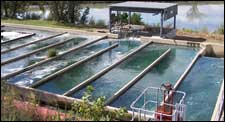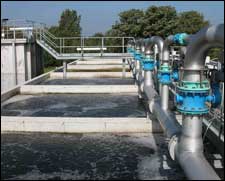 Wastewater treatment is becoming more critical due to shrinking water resources, increasing wastewater disposal costs and stringent regulations that have lowered permissible contaminant levels in waste streams, says Rishabh Sethi, Chief Operating Officer, SPML Infra Ltd, which has infrastructure development projects worth $1.4 billion.
Wastewater treatment is becoming more critical due to shrinking water resources, increasing wastewater disposal costs and stringent regulations that have lowered permissible contaminant levels in waste streams, says Rishabh Sethi, Chief Operating Officer, SPML Infra Ltd, which has infrastructure development projects worth $1.4 billion.
India, the second most populous country in the world, has 17.4 per cent of the world’s total population. But it only has 4 per cent of the world’s freshwater resources, which are declining in terms of both capacity and quality. Groundwater sources are being rapidly depleted, surface water sources are largely contaminated and the infrastructure needed to treat the used water both in urban and rural areas is either non-existent or needs extensive development and upgrades.
A study of water and wastewater management in 71 Indian cities indicates that these cities produce nearly 40,000 million litres of wastewater per day. But, the sewage treatment capacity developed so far is only around 12,000 million litres per day leaving a big gap of almost 70 per cent. CPHEEO estimates that about 70-80 per cent of total water supplied for domestic use gets generated as wastewater. The large gap between the generation of wastewater and its treatment has led to large scale ground water contamination.
Innovations in the area of wastewater treatment focuses that wastewater can be a resource by using new technologies and processes.
The innovations in wastewater treatment have to satisfy a number of criteria:
* to integrate planning with other local services, such as solid waste, organics composting programmes, energy and public services so that a community benefits from wastewater treatment in a variety of ways
* to lower the costs of wastewater treatment through waste recovery and reuse
* to minimise environmental pollution
* to embrace flexibility, so that new innovations and technologies can be employed as they become available
The innovations in wastewater treatment technologies can be implemented depending upon a number of factors, including operating costs, potential revenues, the value of the resources and public acceptance levels for wastewater resources and the engineering needed to create them.
Some of the latest innovations are:
* Decentralised Treatment Plants: smaller and more locally based treatment plants on membrane-based technology to serve populated communities
* Satellite Water Reclamation Plants: such plants are set up remove flows from nearby sewers to produce reclaimed water closer to the use area
* Membrane Separation Technology: treated wastewater using membrane technology can be so clean that it is potable but mostly used for irrigation
* Resource Recovery – biodiesel from fats, oils and grease: fats, oil, and grease (FOG) from wastewater is collected during treatment in plants and converted to biodiesel through esterification and hydrogenation
* Electricity and Heat from Cogeneration: Biogas fueled cogeneration systems help a wastewater facility to utilise energy from the treatment process itself. Cogeneration systems produce electricity and hot water from biogas, a naturally occurring byproduct of sludge dewatering. The electricity produced can be used to supply power to anaerobic digesters in the plant, thus saving on electricity bills.
* Electricity from biogas or sewage powered fuel cells: Methane from sludge dewatering plants can be converted into biogas or into hydrogen, which can be used in direct fuel cells that can be used for the powering of wastewater plants.
* Water-source heat pumps: used to extract residual heat energy from wastewater, after treatment and before discharge by outfall that can be used as an energy resource.
* Reclaimed water from wastewater: using membrane technology, water can be purified and used for irrigation, recharging of water bodies or as a supplement to existing ground and surface water sources
* Biogas from wastewater and sludge: biogas is produced from methane, which is a byproduct of bio solids processing, is already being used to fuel cars, taxis, trucks and public transports in European countries. It can further be refined as a cooking fuel, for use in homes and restaurants; biogas can also be burned in plants along with wood or other waste in order to generate power.

Wastewater process/technology
Wastewater treatment is becoming ever more critical due to shrinking water resources, increasing wastewater disposal costs and stringent regulations that have lowered permissible contaminant levels in waste streams. Wastewater treatment technologies are designed to provide low cost solution with benefits of environmental protection from the reuse of water. There are three commonly used process of wastewater treatment.
Mechanical systems are more suitable for places where land availability is a concern, such as hotels and residential areas. Mechanical plants are the least land intensive of the wastewater treatment methods based on natural processes.
Lagoon and oxidation pond technologies are suitable where there is plenty of land available.
Aquatic and terrestrial plants require relatively large land space and are best suited to regions where suitable plant growth and soil adsorption to convert biologically available nutrients into less-available forms of biomass, which is then harvested for a variety of uses, including methane gas production, alcohol production, or cattle feed supplements.
Energy management is becoming an essential aspect of the process of wastewater treatment facilities. Some operations, such as aeration in biological treatment consume large quantities of energy and consequently the selection of energy-efficient equipment and the design of energy recovery schemes are assuming greater importance. A single wastewater treatment technology would be inappropriate for a country like India which has different geographical and geological regions, varied climatic conditions and levels of population.
It is more appropriate to address the potential by identifying appropriate solutions for different regions. The solutions for wastewater treatment depends on several factors including: i) the volume of wastewater; ii) type of pollutants; iii) the treatment cost; iv) extent of water scarcity in the region, and v) dilution of pollution in the water resources. We need to promote Decentralised Wastewater Treatment Systems (DEWATS), which are locally organised and people-driven systems.
SPML is using new generation technologies such as Membrane Bio Reactor (MBR) and Moving Bed Bio Reactor (MBBR) that can treat the wastewater near to the quality of river water. With suitable renovation this treated water can also recharge flood plains of riverine systems. It is pertinent to mention that the cost for activated sludge process is much lower than that for MBR process. If the treated sewage from MBR technique is recycled and transported to industry as a substitute of fresh water for non-process uses, then the requirement for freshwater will reduced and revenue generation shall be significant.

Wastewater management market
The status of wastewater generation and treatment capacity developed over the decades in urban centres is insufficient and unsuitable. With the population increase, demand of freshwater for all uses will become unmanageable. It is estimated that the projected wastewater from urban centres may cross 120,000 mld by 2051 and that rural India will also generate not less than 50,000 mld by that time given the government plan and development in water supply infrastructures and designs for community supplies in rural areas.
Central Pollution Control Board (CPCB) studies describe that there are 269 sewage treatment plants (STPs) in India, of which only 231 are operational, thus, the existing treatment capacity is just 21 per cent of the present sewage generation. Even the operational plants are not functioning to their design capacity leaving a big gap between wastewater generation and treatment.
As per rough estimate wastewater treatment market is in its growth phase and will gain momentum in the next 5-10 years’ time. Global Water Intelligence has pegged that the wastewater market will be $ 200 billion and growing. Wastewater business is anticipated to provide ample scope for services such as Operations and Maintenance (O&M), Annual Maintenance Contracts (AMC), Technology, Equipment, Chemical etc.
Challenges in wastewater management
If there are good opportunities in the Indian wastewater treatment market, so are there challenges. The biggest of all is the slow pace of implementation of policy reforms in India. But, with the business environment improving, one can expect several new initiatives aimed at water supply, wastewater and sanitation sector. Different industrial segments also offer varied potential for the wastewater treatment markets. Old technologies, traditional methods and ageing infrastructure present challenges in with existing facilities. In the absence of a proper discharge and reuse of treated water utilisation, in most cases the treated water is released to the sewer line thus making the whole effort inept. The replacement or retrofitting of assets poses another challenge in wastewater treatment plants.
With over three decades of experience, SPML Infra has gained a strong foothold in the area of design and construction of wastewater treatment plants. SPML has adopted modern treatment techniques and provide solutions for proper treatment and disposal of municipal and industrial wastewater to ensure that the generated wastewater does not harm our delicate ecosystem and is recycled for further usage.
Some of the signature wastewater treatment plants constructed and maintained by SPML:
* 240-mld sewage treatment plant, Ahmedabad, Gujarat
* 72-mld sewage treatment plant, Okhla, Delhi
* 70-mld sewage treatment plant, Nashik, Maharashtra
* 60-mld sewage treatment plant, Mysore, Karnataka
* 42-mld sewage treatment plant, Kanpur, Uttar Pradesh
* 10-mld tertiary treatment plant, Bengaluru, Karnataka
* 35, 24 & 21.6 mld effluent treatment plants in Delhi











